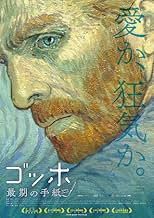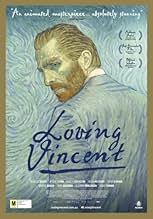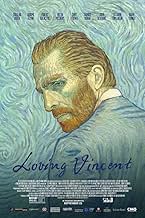Un récit animé dans lequel un jeune homme se rend dans la ville où le peintre Vincent van Gogh a vécu avant de mourir et enquête sur ses derniers jours.Un récit animé dans lequel un jeune homme se rend dans la ville où le peintre Vincent van Gogh a vécu avant de mourir et enquête sur ses derniers jours.Un récit animé dans lequel un jeune homme se rend dans la ville où le peintre Vincent van Gogh a vécu avant de mourir et enquête sur ses derniers jours.
- Réalisation
- Scénario
- Casting principal
- Nommé pour 1 Oscar
- 24 victoires et 54 nominations au total
- The Zouave
- (voix)
- La Mousme
- (voix)
- Pere Tanguy
- (voix)
- The Boatman
- (voix)
- Old Peasant
- (voix)
- Doctor Mazery
- (voix)
- Paul Gaugin
- (voix)
Avis à la une
Technically the film "Loving Vincent" is a wonder of animation. One hundred artists in two countries, (Poland and Greece) working in Vincent's own style contributed full colour paintings for "the present" and black and white paintings for "the past" as the story is being told by the people who knew Vincent.
The film is made up of 853 'shots', and each one began with a first frame of a full painting on canvas board. As the animation photography was done in 12 frames per second, the first painting, would then be photographed, then painted over, with each gradual change to certain details or all of it, until the last frame of the shot. (This is in place of the use of animation cels, which could not be applied in this style of work.) At the end of the 'shot' the film-makers were left with an oil-painting on canvas board, of the last frame. So at the end of filming 853 paintings remained, and 200 are being auctioned off, and many have already sold, (as can be seen from the films own website) although at the time of writing the film has not yet premiered in the USA. The size of the works was usually 67cm by 49cm. Bear in mind that for one hour of film, 43,200 paintings were required, and you will begin to see the extraordinary ambition of this project. Additionally 90 design paintings were created in the planning stages during the year before shooting started. The purpose of these was to define the style in which the artists would all re-create Vincent's style of painting and make it move, live and breathe. 65,000 painted frames in oils were made for the whole film. The story moves along briskly and is full of wonderful characters (the people in Vincent's life). The dialogue of the characters is full of expression, as are the faces, and the characters have been created to really "live" for us. This was done by casting well known and excellent actors in the main roles, and filming them in live-action, then using those 'normal' cinematic images for a basis of the key paintings for each 'shot'. As the film went on, I recognized (from other films) certain of the painted faces of the real actors, who are also giving voice to the painted characters on the soundtrack. This type of animation has never been done before, and as it took seven years to make the film, it might never be done again. The ingenious planning of how to actually do it is brilliant and has been a great success.
Vincent, who suffered, from what we now call bi-polar disease, was an intelligent, deeply sensitive man, who had a sad childhood in a strict bourgeouis family, and was something of a misfit. He showed immense natural art talent. This can be seen clearly and unmistakably by looking at his early drawing. Later he used brush techniques that imitated the 'signature marks' in his pen and ink works. He was understood and saw visual texture.
From Paris Vincent went to Provence, and lived in Arles. He begged his friend Gaugin to come and join him. Vincent was over-joyed but after a few months, things went wrong between them, and Vincent seemed to become very distressed. When Gaugin departed, he was inconsolable. After the famous incident of cutting of his own ear in his distress, he went into care of Dr Gachet in Auvers, where he found a kindred spirit in Gachet, who loved art, and recovered. There he did quite a few more strong drawings and paintings. Vincent saw the world in a kind of almost violent motion and most of his works, drawings and paintings show this. It's as if the wind was visible to him in the air itself, not only in the resulting movements of trees, and fields of grain, or the moving sea.
He never sold a painting in his own lifetime, but gave away some, and sent many to his brother Theo who attempted to sell them in his Paris art gallery. And yet now his works hold the record as being the most expensive ever sold – which happened in modern times.
An animated construction entirely brought to life by oil paintings, is quintessential proof that cinema has still barely scratched the surface of its reaches. Loving Vincent is landmark event for animation and even biographical storytelling through its majestic vision at the last days of Vincent Van Gogh.
Set a after the death of fabled painter, Armand Roulin (Douglas Booth) is possessed with a letter from Van Gogh to his brother Theo before his death, and begins the journey to deliver it. While on call, Roulin encounters all the people close to Vincent before is death gradually trying to put the pieces of what cause his sudden suicide. From this we are taken back to key moments of Van Gogh's life mesmerizingly displayed through the living oil paintings.
Generated by 65,000 paintings by over a 100 artist, Loving Vincent is living work of art. First shot as a live action depiction then adapted into paintings, the immersive gallery of scenes is a first in new format of animation. Directors: Dorota Kobiela, and Hugh Welchman take Van Gogh's own artistry into his own biography (almost), from Citizen Kane style narrative, assessing and celebrating the life of one of the worlds if not the most famous painter. From this production becomes transporting cinema experience into the world of Van Gogh and an enchanting watch of magnificent painting and animation.
Of course what is the fundamental strength of Loving Vincent is its captivating artwork which for every moment is spectacular, and then you have the real narrative of Van Gogh's last days which on its own is an affectionate journey. Even if you don't not much about the life of Van Gogh this is an enthralling experience.
The monumental presence of the paintings is consistently exceptional with wonderful detail and creation put into it. One of the sensational efforts for the film is its sketch of the real actors, making them instantly recognisable on screen, bringing their performance into the art. Although our eyes are set on visual presence, Clint Mansell's score is also a tear-jerking atmosphere throughout the film, capturing the melancholy as well as joy of Van Gogh.
Loving Vincent is a visual sensation, proving the amazing talent that animation brings to the screen. This is by far one of the most significant films of the year and is must see experience, especially for art students.
Le saviez-vous
- AnecdotesEach of this movie's 65,000 frames is an oil painting on canvas, using the same technique as Vincent van Gogh, created by a team of one hundred painters.
- GaffesA fly can be seen for a frame, with it being stuck to the real life painting of the frame.
- Citations
Vincent van Gogh: Who am I in the eyes of most people? A nobody, a non entity, an unpleasant person. Someone who has not, and never will have any position in society. In short, the lowest of the low. Well then even if that were all absolutely true, then one day I will have to show by my work what this nobody, this non entity has in his heart.
- Crédits fousSPOILER: In the closing credits, the tableau for Dr. Gachet discusses the difficulty that experts had in distinguishing the genuine works painted by van Gogh from those painted by Dr. Gachet in the style of van Gogh.
- ConnexionsFeatured in The 75th Annual Golden Globe Awards (2018)
Meilleurs choix
- How long is Loving Vincent?Alimenté par Alexa
Détails
- Date de sortie
- Pays d’origine
- Sites officiels
- Langue
- Aussi connu sous le nom de
- Cartas de Van Gogh
- Lieux de tournage
- Wroclaw, Dolnoslaskie, Pologne(Centrum Technologii Audiowizualnych)
- Sociétés de production
- Voir plus de crédits d'entreprise sur IMDbPro
Box-office
- Budget
- 5 000 000 € (estimé)
- Montant brut aux États-Unis et au Canada
- 6 735 118 $US
- Week-end de sortie aux États-Unis et au Canada
- 23 180 $US
- 24 sept. 2017
- Montant brut mondial
- 42 187 665 $US
- Durée1 heure 34 minutes
- Couleur
- Mixage
- Rapport de forme
- 1.33 : 1
Contribuer à cette page







































